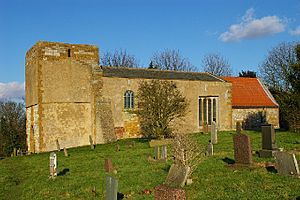St Mary's Church, Barnetby facts for kids
Quick facts for kids St Mary's Church, Barnetby |
|
|---|---|

St Mary's Church, Barnetby, from the south
|
|
| Lua error in Module:Location_map at line 420: attempt to index field 'wikibase' (a nil value). | |
| OS grid reference | TA 061 091 |
| Location | Barnetby, Lincolnshire |
| Country | England |
| Denomination | Anglican |
| Website | Churches Conservation Trust |
| Architecture | |
| Functional status | Redundant |
| Heritage designation | Grade I |
| Designated | 6 November 1967 |
| Architectural type | Church |
| Style | Anglo-Saxon, Norman, Gothic |
| Specifications | |
| Materials | Ironstone, chalk, limestone and brick. Slate and tile roofs |
St Mary's Church is an old Anglican church in the village of Barnetby, Lincolnshire, England. It's not used for regular church services anymore, which means it's a redundant church. This special building is looked after by the Churches Conservation Trust. It's also listed as a Grade I building, which means it's very important and protected.
Contents
History of St Mary's Church
This church is very old, dating back to the 11th century. Some parts of its south wall are even older, built in the Anglo-Saxon style. The church tower was built between the 11th and 12th centuries. The main arch of the tower, the north side of the church, and the chancel (the part near the altar) were added in the 13th century.
Over the years, the church changed quite a bit. In the 17th and 18th centuries, the north side of the church was taken down. A new window was also added to the east end of the chancel. In 1829, a special raised area called a gallery was built inside the church. More changes happened in the 19th century, like replacing the south entrance with strong supports called buttresses. In the 20th century, some parts of the outside were covered with a special coating called rendering, and more repairs were done.
By 1927, people in Barnetby started going to a different church, St Barnabas, which was built nearby. St Mary's Church was no longer used for services. In 1972, it was officially declared "redundant," meaning it wasn't needed for regular worship anymore. Since then, the Churches Conservation Trust has been taking care of this historic building.
During World War II, an Australian airman named Don Charlwood visited St Mary's Church often. He was stationed at a nearby air base. He wrote about his visits to the church in his book, "No Moon Tonight."
Architecture and Design
Outside the Church
St Mary's Church is built from a mix of different materials. These include ironstone, chalk, limestone, and both red and yellow bricks. Some parts of the church's outside walls and the tower have a cement coating. The roof over the main part of the church (the nave) is made of slate. The roof over the chancel is made of tiles.
The church has a simple layout. It has a main area called the nave, a chancel, and a tower at the west end. The tower looks a bit short and wide. It has two main sections and a base. It also has special corner stones called quoins and a decorative band around it. On the west side of the tower, there's a round-topped doorway. Above it is a small, narrow window. Higher up, there are small, round-topped openings for bells on the west and south sides. There's also a square-shaped bell opening on the north side.
On the north wall of the nave, you can still see parts of two old arches. There's also a 15th-century window with three sections and decorative stone patterns. On the south side of the nave, there are two strong supports (buttresses). Between them is a round-topped window that lit the gallery inside. Further east, there's a narrow 11th-century window with a carved lion above it. There's also a large, square-shaped window from the 16th or 17th century with four sections. In the south wall of the chancel, there are two narrow windows. Between them is a doorway that has been filled in. The window at the very east end of the church is round-topped. Above this window, the wall forms a triangle shape called a gable, made of red and yellow brick.
Inside the Church
The arch leading into the tower is pointed. It's partly hidden by the wooden gallery at the west end, which is supported by two wooden columns. On the south wall of the nave, there's a doorway that has been blocked up. On the north wall, you can see where the old arches used to be.
The arch leading into the chancel is also pointed. In the chancel, there's another blocked-up doorway on the south side. The wooden rails in the chancel were made from an older, decorative screen from the 15th century. The wooden pulpit (where the priest gives sermons) has eight sides and was made in the late 18th or early 19th century. It has painted panels.
Inside the tower, there's a carved stone coffin for a baby. The old lead baptismal font (a basin used for baptisms) that used to be in the church is now at the North Lincolnshire Museum in Scunthorpe. The church has three bells, but they can't be rung anymore. The oldest bell was made in 1578, and the other two were made around 1599.
Churchyard Features
The churchyard around St Mary's Church is also important. It contains the war graves of three soldiers from the Royal Engineers. These soldiers fought in the First World War.
See also

